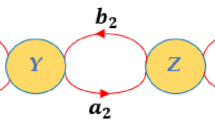Abstract
Based on the master stability function (MSF) analysis, the complete synchronization of coupled chaotic Rulkov neuron networks is investigated in detail. The two-dimensional parameter-space plots that display directly the values of the MSF in different colors are numerically obtained. For the electrical coupled Rulkov neuron network, the values of MSF are all positive when the single Rulkov neuron is in chaotic bursting state or spiking state, which means that complete synchronization of the electrical coupled Rulkov neuron network can not attain. Importantly, a specific inner linking function is found to make the values of the MSF negative, which means that the necessary condition of complete synchronization is satisfied. Through numerical simulations, the existence of complete synchronization is verified for Rulkov neuron network with the very specific inner linking function that has been employed. In addition, the number of nodes of networks and the explicit thresholds for the coupling strength that guarantees the necessary condition of complete synchronization are derived in three typical regular networks. More interestingly, the same route of spatiotemporal patterns transition is found for Rulkov neurons in three typical regular networks.












Similar content being viewed by others
References
Belykh, I., de Lange, E., Hasler, M.: Synchronization of bursting neurons: what matters in the network topology. Phys. Rev. Lett. 94, 188101 (2005)
Belykh, I., Hasler, M.: Mesoscale and clusters of synchrony in networks of bursting neurons. Chaos 21, 016106 (2011)
Boccaletti, S., Kurths, J., Osipov, G., Valladares, D.L., Zhou, C.S.: The synchronization of chaotic systems. Phys. Rep. 366, 1–101 (2002)
Cao, H.J., Sanjuán, M.A.F.: A mechanism for elliptic bursting and synchronization of bursts in a map-based neuron network. Cognit. Process. 10, 23–31 (2009)
Cao, H.J., Wu, Y.G.: Bursting types and stable domains of Rulkov neuron network with the mean field coupling. Int. J. Bifurc. Chaos 23, 1330041 (2013)
de Vries, G.: Bursting as an emergent phenomenon in coupled chaotic maps. Phys. Rev. E 64, 051914 (2001)
Eckhorn, R.: Neural mechanisms of scene segmentation: recording from the visual cortex suggest basic circuits or linking field models. IEEE Trans. Neural Netw. 10, 464–479 (1999)
Heagy, J.F., Pecora, L.M., Carroll, T.L.: Short wavelength bifurcations and size instabilities in coupled oscillator systems. Phys. Rev. Lett. 74, 4185–4188 (1995)
Hu, D.P., Cao, H.J.: Stability and synchronization of coupled Rulkov map-based neurons with chemical synapses. Commun. Nonlinear Sci. Numer. Simul. (2015). doi:10.1016/j.cnsns.10.025
Ibarz, B., Cao, H.J., Sanjuán, M.A.F.: Bursting regimes in map-based neuron models coupled through fast threshold modulation. Phys. Rev. E 77, 051918 (2008)
Ibarz, B., Casado, J.M., Sanjuán, M.A.F.: Map-based models in neuronal dynamics. Phys. Rep. 501, 1–74 (2011)
Izhikevich, E.M., Hoppensteadt, F.: Classification of bursting mappings. Int. J. Bifurc. Chaos 14, 3847–3854 (2003)
Izhikevich, E.M.: Dynamical Systems in Neroscience: The Geometry of Excitability and Bursting. The MIT press, Cambrigde (2007)
Juang, J., Liang, Y.H.: Cluster synchronization in networks of neurons with chemical synapses. Chaos 24, 013110 (2014)
Kocarev, L., Parlitz, U.: Generalized synchronization, predictability, and equivalence of unidirectionally coupled dynamical systems. Phys. Rev. Lett. 76, 1816–1819 (1996)
Nordenfelt, A., Used, J., Sanjuán, M.A.F.: Bursting frequency versus phase synchronization in time delayed neuron networks. Phys Rev. E 87, 052903 (2013)
Qin, H.X., Ma, J., Jin, W.Y., Wang, C.N.: Dynamics of electric activities in neuron and neurons of network induced by autapses. Sci. China Technol. Sci. 57, 936–946 (2014)
Pecora, L.M., Carroll, T.L.: Synchronization in chaotic systems. Phys. Rev. Lett. 64, 821–825 (1990)
Pecora, L.M., Carroll, T.L.: Master stability functions for synchronized coupled systems. Phys. Rev. Lett. 80, 2109–2112 (1998)
Pikovsky, A., Rosenblum, M., Kurths, J.: Synchronization: A Universal Concept in Nonlinear Sciences. Cambridge University Press, New York (2001)
Rabinovich, M.I., Varona, P., Selverston, I., Abarbanel, H.D.: Dynamical principles in neuroscience. Rev. Mod. Phys. 78, 1231–1265 (2006)
Rosenblum, M., Pikovsky, A., Kurths, J.: Phase synchronization of chaotic oscillators. Phys. Rev. Lett. 76, 1804–1807 (1996)
Rulkov, N.F.: Regularization of synchronized chaotic bursts. Phys. Rev. Lett. 86, 183–186 (2001)
Rulkov, N.F., Timofeev, I., Bazhenov, M.: Oscillations in large-scale cortical networks: map-based model. J. Comput. Neurosci. 17, 203–223 (2004)
Singer, W.: Time as Coding Space in Neocortical Processing: A Hypothesis. Springer, Berlin (1994)
Tanaka, G., Ibarz, B., Sanjuán, M.A.F., Aihara, K.: Synchronization and propagation of bursts in networks of coupled map neurons. Chaos 16, 013113 (2006)
Uhlhaas, P.J., Singer, W.: Neural synchrony in brain disorders: relevance for cognitive Dysfunctions and pathophysiology. Neuron 52, 155–168 (2006)
Wang, Q.Y., Duan, Z.S., Feng, Z.S., Chen, G.R., Lu, Q.S.: Synchronization transition in gap-junction-coupled leech neurons. Phys. A 387, 4404–4410 (2008)
Wang, C.X., Cao, H.J.: Parameter space of the Rulkov chaotic neuron model. Commun. Nonlinear Sci. Numer. Simul. 19, 2060–2070 (2014)
Wang, C.X., Cao, H.J.: Stability and chaos of Rulkov map-based neuron network with electrical synapse. Commun. Nonlinear Sci. Numer. Simul. 20, 536–545 (2015)
Acknowledgments
This work is supported by the Natural Science Foundation of China (NSFC) under Project No. 11171017 and the Fundamental Research Funds for the Central Universities under Project No. 2015YJS175.
Author information
Authors and Affiliations
Corresponding author
Rights and permissions
About this article
Cite this article
Sun, H., Cao, H. Complete synchronization of coupled Rulkov neuron networks. Nonlinear Dyn 84, 2423–2434 (2016). https://doi.org/10.1007/s11071-016-2654-z
Received:
Accepted:
Published:
Issue Date:
DOI: https://doi.org/10.1007/s11071-016-2654-z




